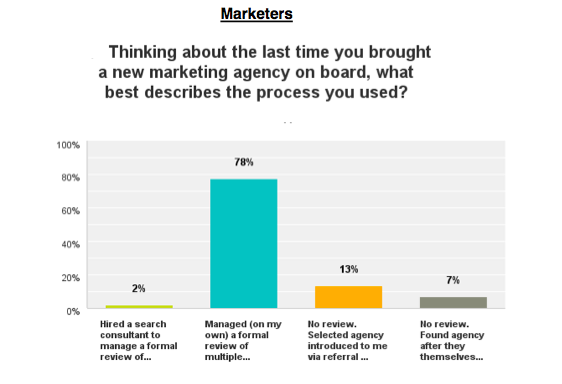How did you acquire your latest client?

For a good majority of small- and mid-size agencies, getting on the search consultancy radar is tough; however, findings from the latest RSW/US new business report show that 77% of marketers surveyed managed searches on their own.
That’s good news for agencies, but it means you have to find those opportunities — and vice versa.
The bad news: Once those opportunities are found, the majority of marketers surveyed (53%) said agencies aren’t aggressive enough when following up after the first meeting.
Working with agencies and marketing service firms every day gives us an inside view into the challenges agencies face, one of those being landing and following through on those crucial first meetings.
Too often, agencies get in their own way or create situations that could have been avoided. They derailing meetings that could have resulted in work.
Here are five situations where agencies don’t get it right and what you should avoid when following up with a prospect:
1) There’s no upfront strategy.
Specifically, the agency wasn’t ready to reach out in the first place or take the referral, but it did.
This is where tightly crafted, purposeful messaging, spoken in the marketer’s language, is critical. And you need the right prospect targets.
Understandably, not every agency has the manpower or funds to generate laser-focused prospect lists.
But you’ve got to take the time to first decide who is the ideal client: where he reside, what his target revenue is, what categories do the business falls in, etc.
Do this, and you automatically clear the first hurdle in acquiring a quality meeting.
2) Agencies throw everything at the wall to see what sticks.
We see too many agencies make illogical leaps from categories they have experience in to categories they think make sense as a natural extension.
The agency had one project more than a decade ago, so the team thinks this gives them the experience to go after the category with reckless abandon.
If they’re talented enough on the sales front to get that first meeting, what often results is a rapid realization on the part of the prospect that there’s not much there.
I’ll never forget wanting to laugh and cry at the same time when Brent Hodgins spoke at a Mirren conference about an agency describing their new business plan, saying, “You know, we really need a beer client, that would be great.”
And that agency had zero beverage experience, but the idea just seemed really sexy.
I’ve had that exact conversation multiple times with agencies.
3) Agencies aren’t willing to talk to prospects unless there’s work in hand.
If it’s the right prospect to begin with (see No. 1), it’s not a useless meeting, even if the prospect doesn’t have work in hand.
Don’t misunderstand: Those work-in-hand, face-to-face first meetings are the ideal, but as we all know, it doesn’t always work that way.
If you’ve done your homework, in theory, any prospect on a good list is worth having a conversation with.
Does that mean you jump on a plane across the country in this scenario? No. But you should take the time to start the relationship.
4) Agencies don’t have case studies, social activity, or relevant, targeted content.
I hear agency principals tell me they lose sleep over how to stay in touch in a meaningful way after that first meeting.
They overthink it and feel they have to touch prospects with amazing, original content that will completely blow the potential client away.
Are there agencies succeeding without case studies, social media, or content? Sure there are.
Are there a lot of them? No.
Busy simply cannot be an excuse. Content in all its forms is a new business fact of life today.
But it doesn’t have to consume you. There are plenty of tools — from platforms to software to blogs — that can help you create a realistic thought leadership strategy.
And it’s even more important after that first meeting.
5) There’s no plan for keeping connected.
This is key: Don’t take this advice, and regardless of how well-suited the prospect is for your business, that first meeting will be useless.
Prospects go dark. Sometimes there’s nothing you can do about that, but you (the agency) going dark should never be the reason a prospect didn’t become a client.
A templated series of emails, coupled with calls and social media, apportioned over weeks or months can be used for every new set of prospects.
Of course you can’t use the same exact copy every time, but agencies get timid about reusing content.
Don’t be. Write once, and use the content at least 5 different ways.
Keep the outreach timing respectful and concise, showing how your agency can help through an overall understanding of the sector.
No way around it, that first meeting is typically just the beginning.
It’s a multiple-step process, but once you have a sound, consistent and manageable game plan, you’re in an infinitely better place to be found.
![How to Create a Profitable Annual Business Plan [+Free Template]](http://53.fs1.hubspotusercontent-na1.net/hubfs/53/00-Blog_Thinkstock_Images/new-biz-planning.png)








